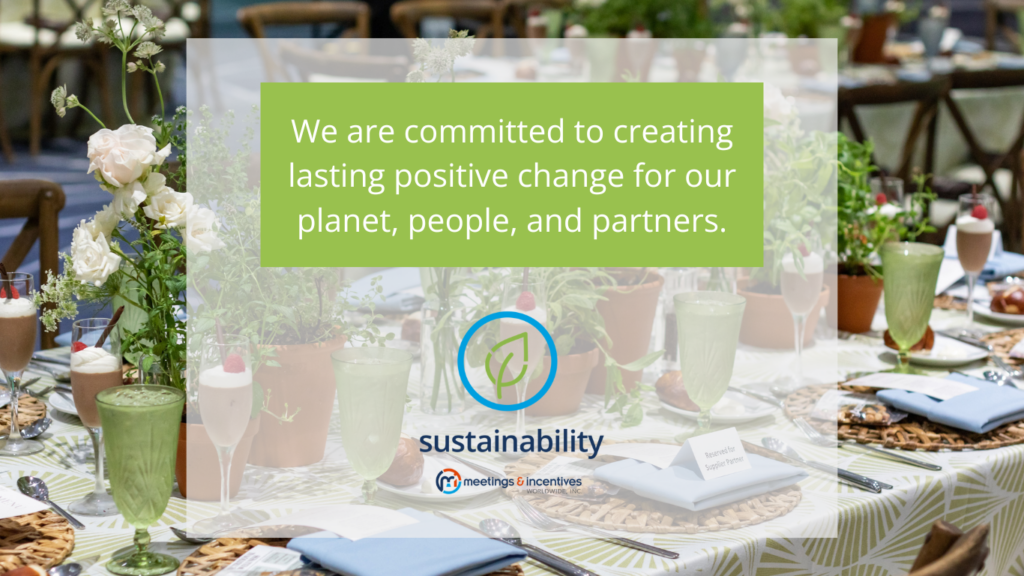Four Steps to Make Event Sustainability a Reality
Originally published on April 18, 2024. Updated on April 3, 2025.
At M&IW, we have long championed sustainable practices for the meetings, events, and incentive programs we manage. As our CEO, Tina Madden, says, “Sustainability is not an initiative. It’s a mindset.”
We are firmly committed to this mindset, but if you’re just starting on your journey to sustainable events, it can seem overwhelming. To make the prospect less daunting, we’re sharing our four-step process to ensure every program is looked at through an environmentally friendly lens. But first, let’s explore some background as to why sustainable event planning is so important.

The Impact of Event Emissions on Event Sustainability
One of the top goals of sustainability efforts is to reduce emissions or, barring that, to at least mitigate them. For the meetings and events industry specifically, the main causes of emissions in order of impact are:
- Travel, 70–90% of which comes from attendee travel.
- Energy used at hotels and venues and by event AV needs.
- Sourcing of materials, including the entire supply chain from fabrication to delivery.
- Food choices, sourcing, and waste.
- Waste, the most visible emissions source to attendees.
While all of the above contribute to an event’s overall emissions, travel has the largest impact by far, accounting for up to 90% of emissions alone. The second largest emissions factor is energy consumption, which averages 8% of an event’s emissions.
Given these statistics, the top two ways to reduce emissions for in-person events is to choose a local or centralized destination for attendees and to prioritize green energy venues, but that doesn’t mean there aren’t other ways to make a difference. Our process detailed below will help you envision what a green event truly entails and how you can maximize your opportunities for event sustainability.
To learn more about sustainable event planning, including the categories of emissions and corporate social responsibility, read Event Sustainability 101.
Four Steps to Creating Sustainable Events
Whether you work with an event agency like M&IW or manage your organization’s programs internally, this four-step process can be easily applied to any meeting, event, or incentive. As you become more experienced and knowledgeable in sustainable event practices, each steps becomes more details to increase your positive impact on the environment.
1. Define
Take the time to define the policies, goals, and measurement baselines for your sustainability efforts. Clearly established goals and timelines provide a roadmap for sustainable event planning. Consider all aspects of the program, from conserving water and energy to reducing travel footprints to gifting with sustainable or reusable packaging.
Be sure to have a way to measure your impact as well. Goals and policies are nothing more than lip service without a way to track how well you did. If you’re not sure how to measure the overall impact of your event, M&IW has tools to make it possible.
2. Plan and Procure
As you go through the event planning process, consider sustainability every step of the way. All event logistics can and should be looked at through an environmentally friendly lens. Don’t forget to tell your vendors and suppliers that sustainability is a priority. They may have eco-friendly products or services you don’t know about, or they may have seen effective practices used at other events.
3. Execute
Once you’ve taken the time to plan a sustainable event, ensure it is properly executed onsite. Use your event marketing to communicate with attendees about what to expect or what changes have been made to support your goals. If you have onsite signage related to sustainability efforts—to make a distinction between trash and recycling bins, for example, or to direct attendees to the nearest water filling station—ensure those signs are large, clear, and reusable or recyclable. It also helps if they’re colorful so that they catch people’s attention.
4. Measure and Learn
Take accountability for your efforts. Measuring your final impact and comparing them to your original goals allows you to both celebrate where you succeeded and identify how to improve in the future. An event retrospective with specific details can then serve as the starting point for your next event. You should always aim to make your next event more sustainable than the last.
Turning Event Sustainability Into a Reality
M&IW can turn your dreams of sustainable meetings and events into reality. In addition to our team’s hands-on experience, we utilize a number of tools, technology, and partnerships at our disposal, including:
- A travel emissions calculator to find the attendee travel footprint post-event and determine the most eco-friendly destination and travel options for future events.
- An energy emissions calculator to measure the energy consumption of a hotel or venue due to your event.
- Food donation partnerships to reduce food waste and give back to the local community.
- A sustainability checklist to reference for every event. You may not be able to check off every item, but your event manager will work with you to help complete as many as possible.
- Partnerships to facilitate the purchase of renewable energy certificates or carbon credits to offset your event’s environmental footprint.
Event sustainability doesn’t have to be expensive or overwhelming. There are many low-cost practices to make your programs more eco-friendly, and any effort is better than no effort. Whether you’re not sure where to begin or want to elevate your existing sustainability solutions, M&IW is here to help.
Contact us or click the button below to learn more about our sustainability initiatives and how they can make an impact for your next program. Already an M&IW customer? Contact your Customer Success Manager.
To stay up to date on the latest trends and insights in event sustainability, follow us on LinkedIn.
Contributor

Donna Collins
Sustainability Champion
Meetings & Incentives Worldwide, Inc.


